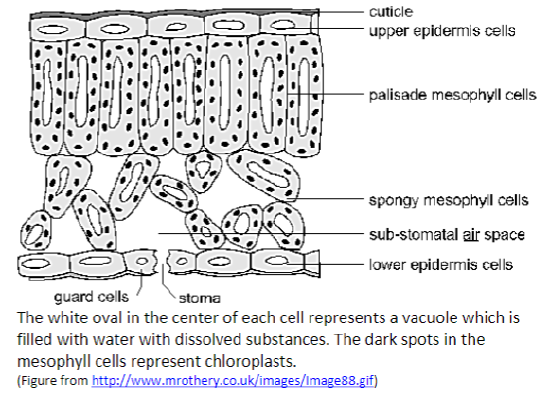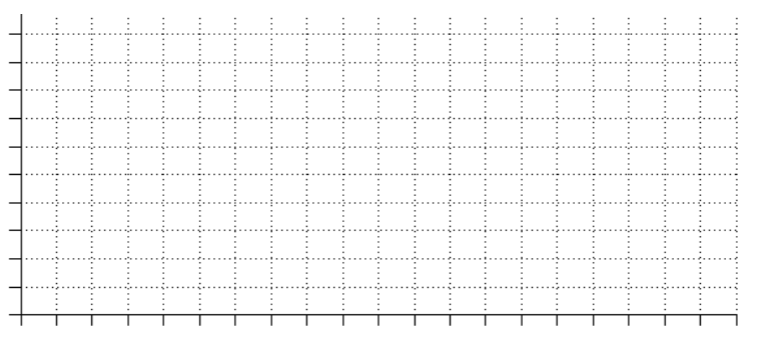2.1: Photosynthesis Protocol
- Page ID
- 25185
I. Measuring the Rate of Photosynthesis
You will use the "floating leaf disk" method to measure the rate of photosynthesis. To begin, cut several disks from a spinach leaf and put these leaf disks in a cup of water.
1. Do your leaf disks float? Use the information in this diagram of a cross-section of a leaf to explain why a leaf disk would float.

2. Where does photosynthesis occur in a leaf? State which organelles carry out photosynthesis and which type or types of leaf cells have this organelle.
3. Explain why it is useful to the plant to have air spaces around the spongy mesophyll cells in the leaves. (Hint: Recall the chemical equation for photosynthesis.)
\[\ce{6 CO2 + 6H2O ->[light] 6 O2 +C6H12O6 }\]
4. To measure the rate of photosynthesis, you will replace the air in the spongy mesophyll in your leaf disks with a liquid. This will cause the leaf disks to sink. Then you will put these leaf disks in water with dissolved CO2 and measure the amount of time it takes for the leaf disks to float. Which product of photosynthesis will accumulate in the spongy mesophyll and cause the leaf disks to float?
For photosynthesis to occur in the leaf disks that have had the air sucked out, you will need to provide the leaf disks with light and a good source of CO2 dissolved in water. For this purpose, you will use a solution of sodium bicarbonate (NaHCO3) in water. Sodium bicarbonate reacts with water as follows:
\[\ce{NaHCO3 + H2O <=> NaOH + H2CO3 <=> NaOH + H2O + CO2}\]
5. Think about what will happen in leaf disks that you put in a solution of sodium bicarbonate vs. leaf disks that you put in water (with no sodium bicarbonate). Which leaf disks will carry out photosynthesis and produce O2?
___ leaf disks in a solution of sodium bicarbonate
___ leaf disks in water (with no sodium bicarbonate)
Explain your reasoning.
You can test your predictions by seeing whether the leaf disks float as a result of producing O2 when placed in sodium bicarbonate solution vs. water. Use the following procedure.
Procedure
a. Label one cup 'sodium bicarbonate' and fill it about one-quarter full with the sodium bicarbonate solution. Label the second cup 'water' and fill it about one-quarter full with water. Add one drop of dilute detergent to each cup.
b. Next, you will prepare your leaf disks, taking care not to damage them. First, prepare two pieces of paper by folding each of them in half and then unfolding it. Your teacher will supply you with a straw, hole punch, or scissors to prepare the leaf disks. Punch out a piece of leaf tissue, avoiding large veins. (If you are using a hole punch, keep it clamped shut as you tap the punch on the table to release the leaf disk onto the piece of paper.) Repeat until you have 10 leaf disks on each piece of paper.
c. Remove the plunger from a syringe, and use one of the folded papers to pour 10 leaf disks into the syringe. Tap them down to the tip of the syringe.
d. Replace the plunger, and push it down to about the 1 mL mark, being careful not to squash the leaf pieces.
e. Suck up ~5 mL of the sodium bicarbonate/detergent solution into the syringe. Hold the syringe upright and push out as much of the air as possible.
f. Put your thumb over the tip of the syringe, and pull back slowly on the plunger to about the 10 mL mark. This creates a vacuum and pulls air out of the leaf. Tilt and swirl the syringe to make sure all disks are submerged in the solution, then hold it for 10 seconds, and then let go of the plunger without removing your thumb from the tip of the syringe. The plunger will snap back into position and solution will enter the leaf disks. If the leaf disks drop to the bottom of the solution in the syringe, you are done. If not, do this again.
g. Remove the plunger and empty the disks into the cup containing sodium bicarbonate solution. Then swirl the cup to dislodge any disks that are stuck to the side of the cup.
h. Repeat steps c-g, but use the water/detergent solution instead of sodium bicarbonate.
i. Place both cups under a bright light.
Safety Precaution: Be careful to keep all liquids away from the light source and electrical cord.
6. At the end of each minute, record the number of floating disks (any disk that is no longer touching the bottom).
| Number of Floating Leaf Disks | ||||||||||||||||||||
|
Minutes |
1 |
2 |
3 |
4 |
5 |
6 |
7 |
8 |
9 |
10 |
11 |
12 |
13 |
14 |
15 |
16 |
17 |
18 |
19 |
20 |
|
In Water |
||||||||||||||||||||
|
Bicarbonate Solution |
||||||||||||||||||||
7. Use your data to make a graph of your results, using different symbols for the leaf disks in water vs. the leaf disks in bicarbonate solution. Be sure to label the axes and symbols.

8. Do your data support your predictions? Explain.
Both photosynthesis and cellular respiration occur in leaf disks in bicarbonate solution.
|
Photosynthesis |
6 CO2 + 6H2O ⇒ 6 O2 +C6H12O6 |
|
Cellular Respiration |
6 O2 +C6H12O6 ⇒ 6 CO2 + 6H2O V energy V ~29 ADP + phosphate ⇒ ~29ATP |
Note that some of the O2 produced by photosynthesis is used for cellular respiration. Thus, the floating leaf disk method measures the rate of net photosynthesis, which is the rate of photosynthesis minus the rate of cellular respiration.
9. In the chart above, draw arrows to indicate how the products of cellular respiration can be used for photosynthesis and the products of photosynthesis can be used for cellular respiration.
10. Suppose that a leaf disk that has had the air sucked out is placed in bicarbonate solution under a dim light that results in a low rate of photosynthesis that just equals the rate of cellular respiration. Would you expect this leaf disk to float? Explain why or why not.
11. What happens to the sugar molecules produced by net photosynthesis? I.e., how does a plant use the sugar molecules produced by photosynthesis that are not used in cellular respiration?
12. Why do leaf cells need to carry out cellular respiration?
II. Investigating a Factor That Influences the Rate of Photosynthesis
Now that you have a way of measuring the rate of net photosynthesis, you can investigate factors that influence the rate of net photosynthesis. You have already shown that net photosynthesis does not occur if CO2 is not available. What other changes in your experimental set-up might influence the rate of net photosynthesis?
13. Complete the table to describe two additional factors or variables that you think may influence the rate of net photosynthesis and describe the effects you would expect to observe.
|
Factor 1 |
Factor 2 |
|
|
Name or describe a factor that may influence the rate of net photosynthesis. |
||
|
What effect do you think this factor will have on the rate of photosynthesis? Explain your reasoning. |
||
|
What effect do you think this factor will have on the rate of cellular respiration? Explain your reasoning. |
||
|
What effect do you think this factor will have on the rate of net photosynthesis? Explain your reasoning. |
Design an experiment that could test the effect of a factor on the rate of net photosynthesis. Your teacher can supply you with:
- Sodium bicarbonate, water, scale, and graduated cylinder to make solutions with different concentrations of sodium bicarbonate
- A ruler to measure the distance from the light source (light intensity decreases with distance; specifically, light intensity is approximately proportional to 1/distance2)
- Aluminum foil or a box to prevent light from reaching the disks in the beaker
- Different color filters or cellophane wrap that allow through only green light, blue light, or red light
- A thermometer and a larger container that can be filled with hot water or ice to serve as a warming or cooling bath for the beaker with the solution of sodium bicarbonate and leaf disks.
You may be able to use additional equipment or supplies available in your classroom or brought in by one of the students in your group.
14. Describe your proposed experiment, including your research question or hypothesis, your experimental setup, how you will collect and analyze your data, and how you will interpret your data to answer your question or test your hypothesis.

